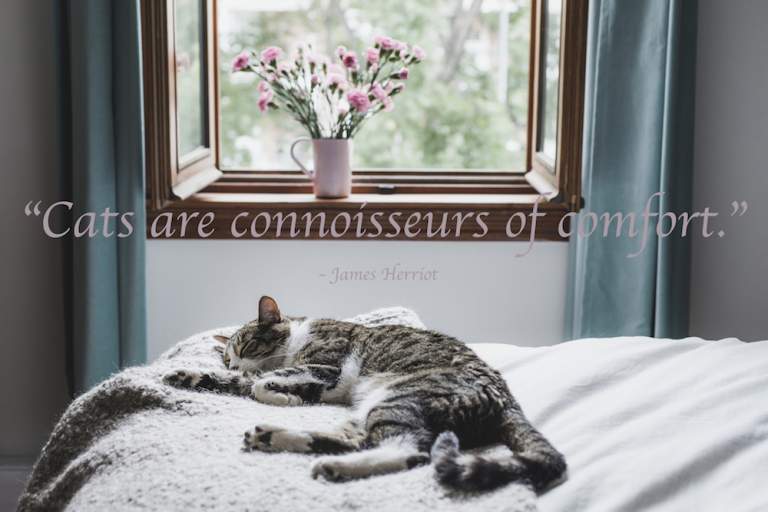
See the alliteration? Or better yet, “c” the alliteration?
It’s fun to craft rhetorical devices into our writing and editing projects. In the image above, James Herriot says, “Cats are connoisseurs of comfort.” He used a rhetorical device — alliteration — to create an imaginative effect in his writing by using the consonant “c” over and over again.
Alliteration deals with consonants that are not vowels (A, E, I, O, and U). Instead, alliteration focuses on all the other alphabet letters representing non-vowels. The use of alliteration just one of several rhetorical devices we can tuck into our writing and book editing projects, along with metaphor, simile, onomatopoeia, repetition, figurative language, logos, pathos, ethos, kairos, and even rhetorical questions — we’ll get to those in future blog posts.
What is alliteration?
Alliteration is the repeated sound of the first consonant letter (or first two-letter combo) in a word. That same first consonant letter appears in a string of words in an alliterative sentence. For instance, we’ve all heard of the following tongue-twisters, which are extreme examples of alliteration:
- Peter Piper picked a peck of pickled peppers.
- A good cook could cook as much cookies as a good cook who could cook cookies.
- Three grey geese in a green field grazing. Grey were the geese and green was the grazing.
The last example — Three grey geese in a green field grazing. Grey were the geese and green was the grazing — has a combination of “gr” and “g” sounds. Therefore, we have alliteration for both.
What are the various types of alliteration we can use in editing projects?
Let’s discuss the four types of alliteration.
- General alliteration (described above)
- Consonance
- Assonance
- Unvoiced alliteration
Consonance
Consonance is the repeating consonant letter sounds at the beginning, middle, or end of a word (as opposed to strictly the beginning sounds as in alliteration). For this reason, some wordsmiths disagree about lumping consonance into the definition of alliteration and feel they should be discussed as subsets. However, I think that as writers, the similarities are enough to justify their inclusion in this explanation of alliteration and our editing projects.
An example of consonance can be found in this sentence: Examples follow:
- Pitter-patter, pitter-patter. **repetition of “t,” and “r” sounds
- I held my nose in the breeze so I would not sneeze on your knees. **repetition of the “z” sound caused by “z” and “s”
- Borrow, and you’ll have sorrow **repetition of the rhyming “orrow” in both words
- Toss the glass, boss. **repetition of “ss”
The following tongue-twisters are also both consonant and alliterative:
- She sells seashells by the sea-shore.
- How much wood would a woodchuck chuck if a woodchuck could chuck wood?
- I slit the sheet, the sheet I slit, and on the slitted sheet I sit.
Assonance
So, are vowels ever alliterative? For the purposes of this blog post, YES! Next up is assonance — the repetition of vowel sounds in nearby words. Assonance, just like alliteration and consonance, affects the rhythm, tone, and mood of a sentence of passage.
Some of the greatest writers in literature and stage have used assonance.
“And so all the night-tide, I lie down by the side of my darling-my darling-my life and my bride.” — Edgar Allan Poe’s Annabelle Lee with repetition of the long i sound.
“The rain in Spain stays mainly on the plain.” — from My Fair Lady with repetition of the long a sound.
“Tyger, Tyger burning bright in the forest of the night.” — from William Blake’s Tyger with repetition of the long i sound.
Unvoiced alliteration
Some letters in words might not be pronounced, but still contribute to alliteration. Examples are posted below:
The dog gnawed the knot all through the night and finally escaped his leash. **both the “gn” and “kn” are alliterative and have silent letters.
The apple pie was apropos for the asthmatics at the picnic. **the “a” words are alliterative, and the silent “s” in apropos and the silent “th” in asthma are unvoiced.
Contact me with Your Editing Projects
I hope this blog post has helped inspire you to use alliteration, consonance and assonance in your creative writing and editing projects. It would be an honor to work with you as you seek to make your book ready for publication.
Send an email at melaniesaxton@icloud.com and we’ll discuss the ins and outs of your special manuscript.
